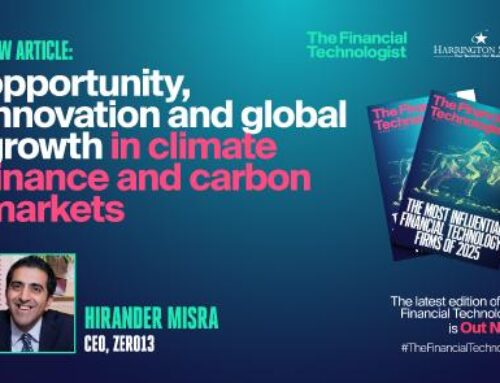By Hirander Misra, CEO of GMEX Group and Chairman of GMEX Technologies
Being a financial exchange services provider has rarely been as hard or competitive as it is today. As the business models for exchanges and trading venues continue to evolve, the technological requirements to run them – be they established entities or a new entrant such as a digital asset exchange – are shifting as well.
Modern exchanges need to meet a variety of requirements to service clients, from providing low latency order matching engines and agile multi-asset trading platforms to offering flexibility with regards to language, trading methods, and data models encompassing both traditional and digital assets. The days of operating a simple equity exchange, solely in English, with little concern for operational costs, are over, and consequently simply embracing the traditional exchange technology model is no longer the obvious way forward.
The Fourth Industrial Revolution (4IR) is driving technological innovation in many spheres and with it comes the need to move from analogue to digital – to Exchange 4.0. The industry-changing network will see exchanges, trading venues, post trade operators, custodians and other services interconnect more seamlessly, with the ability to swap services and assets across jurisdictions and across different types of users. This transformational solution will necessitate digital exchange trading systems and order matching engines to transition from the legacy solutions that have been around for decades.
Low, deterministic latency
One of the highest profile requirements from many trading partners for exchanges these days is the need for low latency trading systems with integral high speed matching engines. Yet speed by itself is not sufficient to attract algorithmic traders. In particular, whilst an exchange may have low latency, more importantly will be low standard deviation in the latency so that algo trading models work consistently and profitably. Such consistency allows effective bid-ask spread decomposition by market makers and reduces issues around make-or-take liquidity pricing. Whether any of us like it or not, algo trading is a crucial aspect of markets these days, which requires providing not just low but also deterministic latency.
Flexibility
In addition, exchanges today need to move beyond the traditional equity-driven data models and embrace the world of cross-asset trading. That means exchanges need to offer flexibility to clients around data models that service different types of asset classes such as securities, derivatives (futures and options), commodities and currencies as well as newer forms of digital assets such as security tokens (digital securities), cryptocurrencies and other types of asset backed tokens.
Servicing multiple asset classes means that exchanges need to embrace trading from around the globe, by offering a platform that works with multiple languages as well as handling different trading methods and matching algorithms. Functionality needs to be built into the core exchange matching engine – such as primary issuance, Request for Quote (RfQ), auctions, block book trading and central limit order book matching – in an integrated fashion. Additionally, we are seeing the traditional centralised model of an exchange challenged by a decentralised approach including blockchain distributed ledger technology.
Exchanges therefore need to adapt to using hybrid trading models, combining traditional with new digital asset solutions in a way that will both add value today and address the evolving requirements of tomorrow, which includes the requirement to handle 24-hour trading.
Low running costs
Despite the exchange members increased requirements, there is an industry expectation to receive this new value with cost effective start-up and ongoing fees. Key to this is to reduce or even eliminate any third-party license costs. Practically speaking, this requires exchange trading system and order matching engine technology providers to deliver services on a small hardware footprint while maintaining high throughput, resulting in reduced server costs and lower data centre expenses in terms of racks, power usage and management fees.
Equally important, exchanges need to be assured that their service operates with software license costs that are transparent and open; all too often hidden costs and extra fees levied by exchange matching engine and trading system technology providers, come as a surprise when exchanges want to expand the scope of their offering. Exchanges should also look to understand and embrace the cost efficiencies of a centralised code base with distributed platform deployment, which, if offered by a provider, will allow them to benefit from standard changes others make and vice versa.
Agility
Modern exchange operations need to be associated with agile and efficient processes and technologies that can be scaled quickly. The benefits of such agility should go beyond cost — as technology continues to evolve, being flexible with business process operations can deliver greater resiliency to competitive threats now and in the future. With exchange matching engines being increasingly required to handle different trading and quoting models, agility in responding will become a crucial factor that determines which exchange and trading venues thrive and which falter.
Conclusion
The reality is that the modern exchanges and trading venues need to offer their customers a lot more than traditional single asset or multi-asset trading platforms and matching engines can provide. Exchange matching engines, digital trading platforms and post trade systems need to embrace a hybrid ecosystem approach, which bridges the gap between traditional and digital capital markets. And all of this must be underpinned by regulatory frameworks, including traditional and digital assets, digital currencies, security tokens, and digital securitisation of traditional assets such as derivatives and commodities.
Embracing the new generation of digital trading solutions can ensure rapid response to evolving needs for both traditional business and newer digital asset driven business enablement in ways that offer advantages of both buy and build.
Now is the time for exchanges and trading venues to adopt Exchange 4.0 – to increase revenue opportunities, lower costs and future proof innovation led digital transformation!




